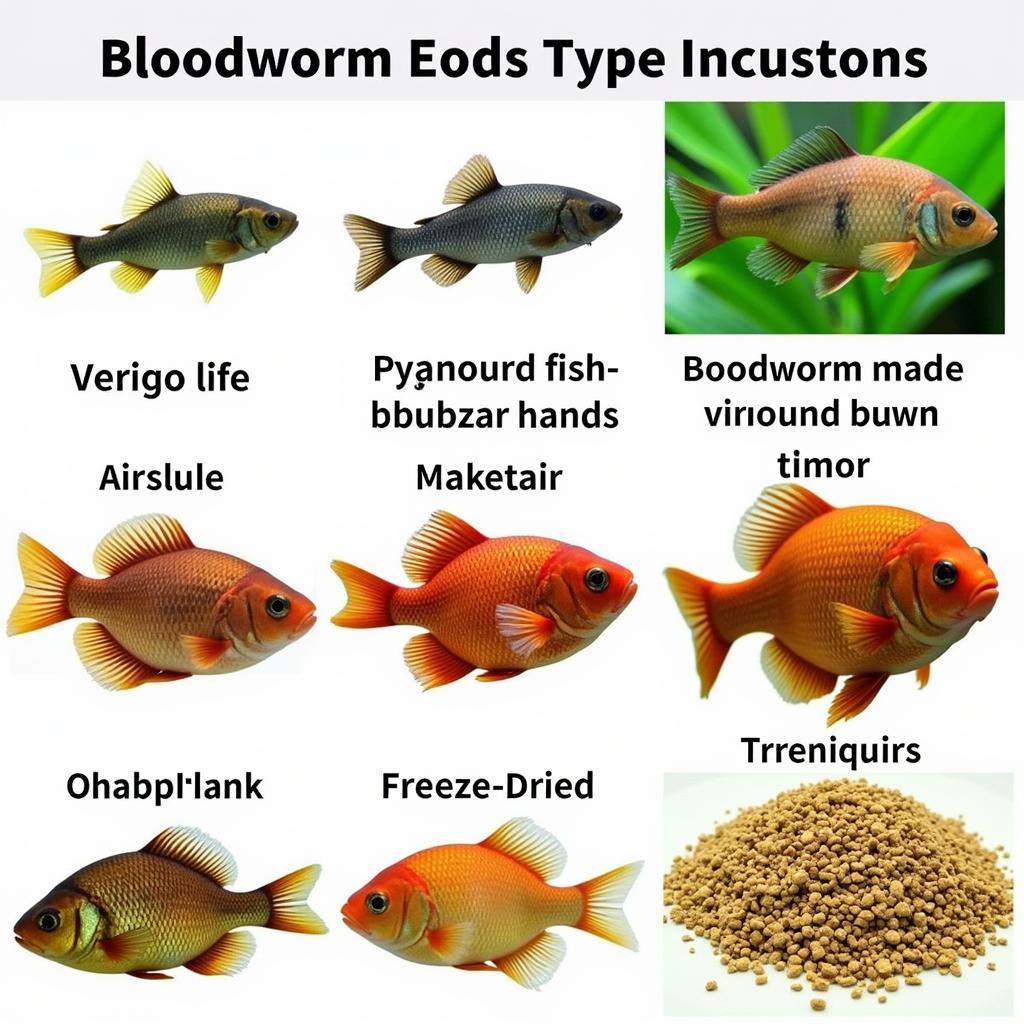Bloodworm Food is a popular choice for aquarium owners looking to provide their fish with a nutritious and appealing meal. These small, red larvae are packed with protein and other essential nutrients, making them an excellent supplement to a balanced fish diet. Whether you’re a seasoned aquarist or just starting out, understanding the benefits and proper usage of bloodworm food is crucial for the health and well-being of your aquatic companions. Let’s dive into the world of bloodworm food and explore everything you need to know.
Why Choose Bloodworm Food for Your Fish?
Bloodworms are a natural food source for many fish species in the wild, offering a taste of their natural diet in the confines of an aquarium. Their rich protein content contributes significantly to healthy growth and development, particularly in young fish. Besides protein, bloodworms contain essential fatty acids, vitamins, and minerals that boost the immune system and enhance the vibrant coloration of many fish species. They are a particularly good choice for picky eaters, as their strong aroma and wriggling movement often entice even the most reluctant feeders. Want to learn more about the best food options for neon tetras? Check out our guide on best food for neon tetras.
Using bloodworm food can also contribute to a more active and engaging environment within your tank. The natural hunting instincts of some fish are stimulated by the movement of live or freeze-dried bloodworms, providing valuable enrichment. This can help alleviate boredom and promote natural behaviors, leading to a healthier and more stimulating life for your fish.
Different Types of Bloodworm Food: Live, Frozen, and Freeze-Dried
Choosing the right type of bloodworm food depends on several factors, including your fish species, tank setup, and personal preferences. Live bloodworms are the most natural option, providing the most stimulation and closest resemblance to their wild diet. However, live bloodworms can carry parasites or diseases if not sourced from a reputable supplier. Frozen bloodworms are a convenient and safe alternative, retaining most of the nutritional value of live bloodworms without the risk of introducing harmful pathogens. Freeze-dried bloodworms offer the longest shelf life and are easy to store, though they lack the movement that attracts some fish. For more insights into freeze-dried options, see our dedicated page on bloodworms freeze dried food.
How to Feed Bloodworms to Your Fish
The feeding method for bloodworms varies depending on the type you choose. Live bloodworms can be introduced directly into the tank, allowing fish to hunt and capture them. Frozen bloodworms should be thawed before feeding to prevent digestive issues. You can also consider specific types of bloodworm fish food tailored to particular needs. Learn more on our page dedicated to bloodworm fish food. Freeze-dried bloodworms can be rehydrated or fed directly to the fish, though rehydrating them can make them more palatable. Regardless of the type, avoid overfeeding, as excess food can decay and negatively impact water quality. Concerned about overfeeding? Read our article about whether can a fish choke on food.
 Feeding Bloodworms to Different Fish Species
Feeding Bloodworms to Different Fish Species
Bloodworms for Specific Fish Species
While bloodworms are a generally accepted food source for many fish, some species benefit more than others. Carnivorous and omnivorous fish, such as Bettas, Tetras, and Discus, thrive on the high protein content. Discus fish, in particular, benefit from the nutrients in bloodworms. Explore our discus fish food page for more specific information. Smaller fish may require chopped or smaller-sized bloodworms to prevent choking.
“Bloodworms are an essential part of a balanced diet for many of my fish,” says renowned aquarist, Dr. Amelia Rivers. “Their nutritional value and palatability make them a valuable addition to any aquarium feeding regimen.”
Conclusion
Bloodworm food provides a nutritious and enriching dietary component for a wide range of aquarium fish. By understanding the different types available and following proper feeding practices, you can ensure your fish receive the maximum benefits of this valuable food source. Remember to choose the type of bloodworm food that best suits your fish’s needs and always practice responsible feeding habits to maintain a healthy and thriving aquarium environment.
FAQ
- How often should I feed bloodworms to my fish?
- Can I feed bloodworms to fry?
- Are there any risks associated with feeding bloodworms?
- Where can I buy high-quality bloodworm food?
- How do I store bloodworm food properly?
- Can I culture my own bloodworms?
- What are some alternatives to bloodworm food?
Common Questions
- My fish won’t eat bloodworms. What should I do?
- Can I mix bloodworms with other fish foods?
- How can I tell if my bloodworm food is contaminated?
Further Reading
For additional information on fish nutrition and care, explore other articles on our website.
For any assistance, please contact us at Phone Number: 02437655121, Email: minacones@gmail.com, or visit us at 3PGH+8R9, ĐT70A, thôn Trung, Bắc Từ Liêm, Hà Nội, Việt Nam. We have a 24/7 customer service team.